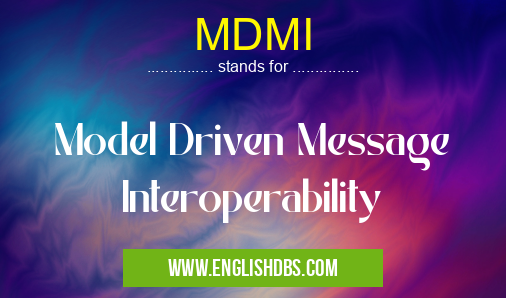What does MDMI mean in UNCLASSIFIED
MDMI stands for Model Driven Message Interoperability. It is a process that facilitates communication and data exchanges between multiple organizations, such as hospitals, banks, and government agencies. It provides the ability to communicate via multiple communication protocols in a reliable and secure manner. The MDMI approach uses technology to enable seamless exchange of information across different systems and organizations, making it easier for all stakeholders to connect with each other without relying on manual data entry. The goal of this process is to create an environment where all users can securely share data with other organizations in an efficient manner.

MDMI meaning in Unclassified in Miscellaneous
MDMI mostly used in an acronym Unclassified in Category Miscellaneous that means Model Driven Message Interoperability
Shorthand: MDMI,
Full Form: Model Driven Message Interoperability
For more information of "Model Driven Message Interoperability", see the section below.
Concept
MDMI follows a model-driven approach which involves setting up a reference model that defines the objects, procedures, data formats and rules for exchanging information between two systems or organizations. This reference model is then used as the basis for creating message exchanges between these two entities using different communication protocols such as HTTP/S or FTP. Through the use of this technology, it ensures that messages are securely exchanged between the two parties without anyone else being able to access them. Furthermore, certain aspects of the messages like data formats can be standardized by taking into consideration all possible scenarios while still allowing users flexibility when sending messages through various protocols or applications.
Advantages
The use of MDMI offers several advantages over traditional approaches. Firstly, it allows organizations to quickly set up message exchanges between multiple systems in a uniformed manner without having to manually set up numerous connections or settings manually. Secondly, there are multiple protocols available for companies to utilize depending on their needs. Lastly, MDMI also increases security by ensuring that messages are sent encrypted and safeguarded against any unauthorized access or tampering attempts. This helps protect confidential information from being exposed during transmission from one system to another.
Disadvantages
While there are many benefits associated with utilizing MDMI technology, there are some drawbacks associated with it as well. For example, due to its complexity certain aspects of implementation may require expertise beyond what some companies have available in order to take full advantage of its capabilities. Additionally though successful implementation requires technical knowledge; lack of integration experience can cause delays in tuning production quality code which could lead project timelines getting extended and potentially delays going live.
Essential Questions and Answers on Model Driven Message Interoperability in "MISCELLANEOUS»UNFILED"
What Is MDMI?
MDMI (Model Driven Message Interoperability) is a standards initiative designed to enable separate systems to communicate with each other in a much simpler way than they do today. By relying on Model Driven Architecture (MDA) techniques, it enables the development of systems in which the underlying data models are easily exchanged amongst any number of applications or systems.
How Does MDMI work?
The basic principle behind MDMI is that communication between two separate systems begins by establishing a common model. This model then defines what information needs to be exchanged and how it should be structured in order for both ends of the conversation to understand each other. Once this established, all parties can interact using the agreed upon structure and data types.
What Are the Benefits Of MDMI?
The benefits of using an MDMI approach are numerous, ranging from improved data accuracy and consistency across different applications, to increased agility when responding to changing business requirements. By facilitating automated translation between different standards, it also reduces complexity as well as costs associated with manual interpretation and mapping of data between individual systems.
Is There Any Limitation Of Using MDMI?
While the principles behind MDMI have potential to revolutionize system interoperability, there are still some limitations that need to be taken into consideration when implementing this approach. For instance, since the language used by MDA tools is complex and requires expertise in order for accurate implementation, it may not be suitable for small-scale projects or those with limited budgets or technical resources. Additionally, even though existing standards like XML can be leveraged by developers wanting to implement robust model-driven architectures, there is always a risk of overlooking important aspects that could compromise interoperability later down the road.
Does Implementing An MDMI System Require Specific Software Platforms And Technologies?
Yes - Unlike other approaches that rely on manual integration techniques such as file format transformation or proprietary APIs, implementing an MDMI system requires specific software platforms and technologies such as XML schemas and Universal Description Discovery Integration (UDDI). Additionally, specific protocols such as SOAP (Simple Object Access Protocol) or messaging formats like EDI must also be considered depending on the requirements involved in any particular project.
What Are The Challenges Associated With Developing An MDMI Solution?
Developing an effective and fully compliant solution based on this approach typically involves significant upfront effort in terms of gathering requirements from stakeholders who will participate in the messaging process as well as designating resources responsible for designing a secure and reliable infrastructure capable of maintaining high throughput levels even under peak load conditions. Additionally due to its very nature, any changes impacting one end of the connection must also be reflected at all other locations within reasonable amounts of time.
Final Words:
MDMI is an invaluable tool when implementing large-scale projects which involve transferring sensitive information between multiple systems owned by different companies or organisations. It allows these companies to securely communicate with each other by establishing standardized formats across processing platforms while still providing them with flexibility when defining how they wish these formats should look like during transmission over various communication protocols such as HTTP/S or FTPs. Additionally it also helps enhance security by encrypting messages thus eliminating any threat posed from someone intercepting them while in transit from one system to another.
